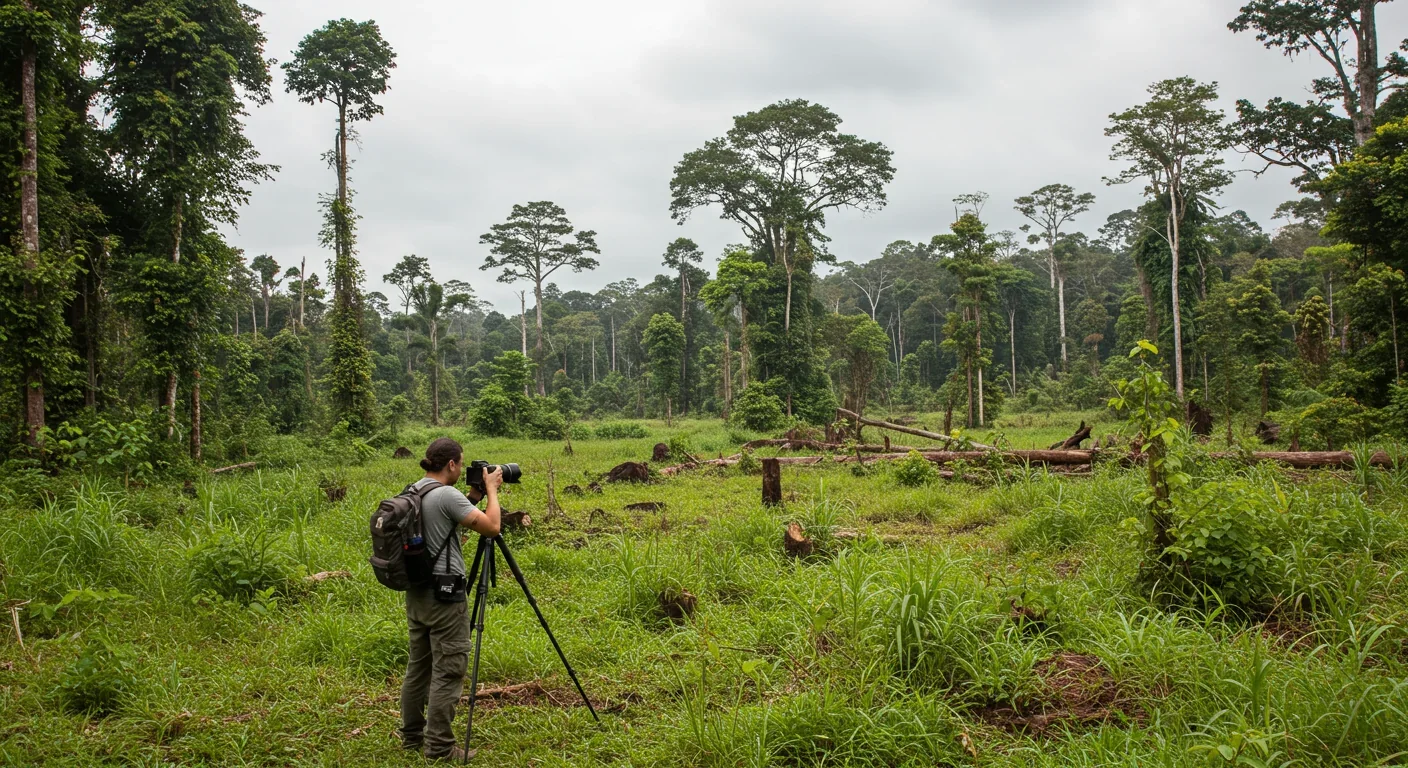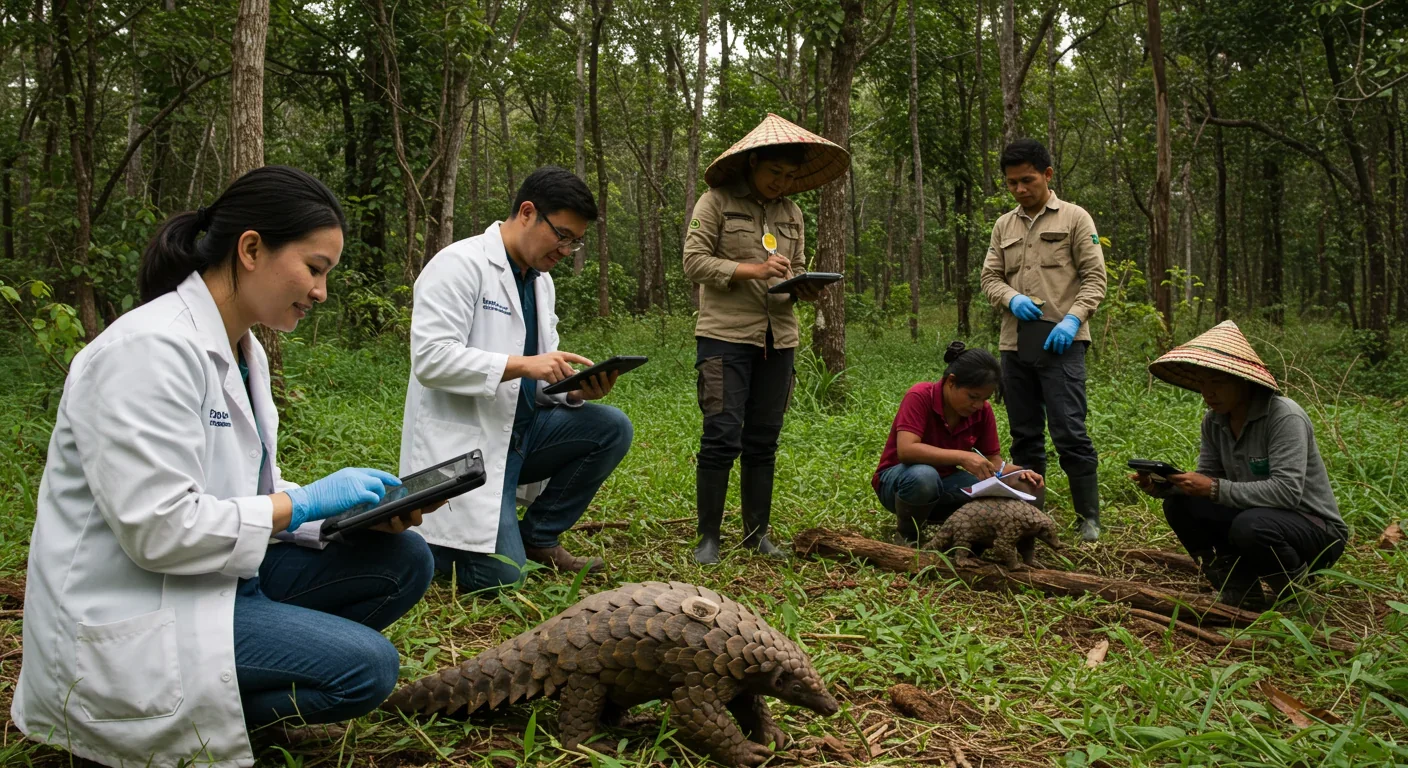Bombardier Beetle Chemical Defense: Nature's Micro Engine

TL;DR: Current extinction rates are 100-1,000 times higher than normal, threatening 25% of species by 2050. While debate continues over whether we're in a true mass extinction, habitat loss, climate change, and overexploitation are driving unprecedented biodiversity decline—but conservation efforts show we can reverse the trend if we act now.

By 2050, biologists predict that 25% of Earth's species could vanish forever. That's not a distant sci-fi scenario playing out in some parallel universe. It's happening right now, quietly, while most of us scroll through our feeds and go about our daily routines. More than 9,000 plant and animal species are listed as critically endangered, each one teetering on the edge of oblivion.
Here's the uncomfortable truth: current extinction rates are 100 to 1,000 times higher than what scientists call the "background" rate—the normal pace at which species naturally disappear over geological time. Think of it like this. Under normal circumstances, maybe one species out of a million would go extinct each year. Now? We're losing species at such a staggering pace that some researchers have labeled our era the sixth mass extinction.
But before panic sets in, there's a critical nuance to understand. Not everyone agrees we've crossed that threshold yet.
Mass extinctions are defined by a specific benchmark: the loss of 75% of all species within a relatively short geological timeframe. Earth has experienced five of these catastrophic events over its 4.5-billion-year history, from the asteroid that wiped out the dinosaurs 66 million years ago to the Permian extinction that eliminated about 90% of all species 251 million years ago.
A recent study published in PLOS Biology examined more than 22,000 genera—groups of related species—and found that only 102 have gone extinct in the past 500 years. That's less than half a percent. The research, led by John Wiens at the University of Arizona, revealed that genus-level extinction rates have actually slowed since their peak in the late 1800s and early 1900s, possibly because conservation efforts for birds and mammals have started working.
This doesn't mean everything's fine. Far from it. While we may not technically be in a mass extinction event yet, we're losing individual species at an alarming rate. More than 900 species have disappeared in those same 500 years. The global abundance of monitored wildlife populations has plummeted 73% since 1970, with freshwater species hit hardest at an 85% decline.
The debate isn't whether biodiversity is in crisis—it absolutely is. The question is whether using the term "sixth mass extinction" helps or hurts conservation efforts.
The drivers of extinction today look nothing like the asteroid strikes and volcanic eruptions of the past. This time, we're the asteroid.
Habitat loss ranks as the primary threat, affecting 85% of all threatened species. Picture the Amazon rainforest, home to more than 10% of Earth's terrestrial biodiversity. Between 2016 and 2020, deforestation in the Amazon increased 92% compared to the previous decade. Every tree that falls takes with it countless insects, birds, and other species that depend on that specific ecological niche.
Then there's climate change, rapidly becoming the dominant threat because it reaches even uninhabited areas. Research shows that global warming could push 5.2% of species to extinction with just a 2°C temperature increase, and 16% with a 4.3°C rise. For species like the Bramble Cay melomys—a small rodent that became the first mammal to go extinct directly from climate change in 2019—rising sea levels simply swallowed their island home whole.
Overexploitation takes many forms. About 20 million tropical fish and 12 million corals are harvested annually just for the aquarium trade. Poaching devastates populations. The illegal wildlife trade pushes species toward extinction while also reducing their genetic diversity, making survivors more vulnerable to disease and environmental change.
Invasive species create chaos wherever humans introduce them. The brown tree snake accidentally brought to Guam around 1960 systematically wiped out all the island's native land birds within decades. Similarly, amphibian chytridiomycosis—a fungal disease spread through global trade networks—has driven countless frog species to the brink worldwide.
These threats don't operate in isolation. They compound. A forest fragmented by development becomes more susceptible to invasive species. Species stressed by habitat loss struggle more with climate shifts. It's death by a thousand cuts.

If you want to see extinction in real time, look to islands. Three out of four extinct genera identified in the Wiens study were island endemics—species found nowhere else on Earth.
Islands like the Mascarene Islands, Hawaiian Islands, and New Zealand suffered the heaviest losses. Why? Isolated ecosystems magnify vulnerability. When invasive predators, hunting, or habitat destruction arrive, island species have nowhere to retreat. The entire evolutionary branch can vanish.
Take the dodo, perhaps history's most famous extinction. This flightless bird evolved on Mauritius without natural predators. When humans arrived with rats, pigs, and hunting, the dodo disappeared within a century. Similar stories played out across Pacific islands, the Caribbean, and Saint Helena, where mollusk diversity was particularly devastated.
Even freshwater systems mirror this pattern. All four extinct genera of ray-finned fishes lived in rivers or lakes—essentially "islands" of water surrounded by uninhabitable land.
The island story matters because it previews what happens when species run out of space. As human activity fragments habitats worldwide, we're essentially creating ecological islands everywhere. Species trapped in shrinking patches of suitable habitat face the same fate as island endemics.
Here's where the story gets more hopeful. The slowdown in genus-level extinctions over the past century isn't random. It's evidence that when humans decide to act, we can make a difference.
The Endangered Species Act, passed in 1973, protects imperiled species and their ecosystems. It's prevented countless extinctions. The California condor was down to just 27 individuals in 1987. Through captive breeding and reintroduction, more than 500 now soar over California, Arizona, and Mexico.
Protected areas have expanded dramatically. More than 300,000 protected zones now cover 21 million square miles—18% of land and 8% of marine and coastal areas. That's a 1 million square mile increase from 2020 alone.
The Kunming-Montreal Global Biodiversity Framework commits 194 countries to protecting 30% of land and marine areas by 2030—the "30x30" initiative. If achieved, this would safeguard vast swaths of critical habitat.
Species distribution modeling helps scientists identify exactly where endangered species can survive, both now and under future climate scenarios. Research on endemic plants in Egypt's Saint Catherine Protectorate showed that while some species face shrinking habitats, others may actually expand their range if protected areas provide climate refugia—cooler, wetter microclimates where species can persist.
Conservation isn't just about government action. Community-based initiatives make huge impacts. Indigenous communities, who manage a significant portion of Earth's biodiversity, often prove to be the most effective stewards. Their traditional knowledge and long-term connection to the land creates sustainable management that protects both species and human livelihoods.

Losing a species means more than just one less picture in a nature documentary. It unravels entire ecosystems in ways that directly affect human well-being.
Biodiversity provides ecosystem services worth trillions. Pollinators like bees, birds, and insects are responsible for one-third of the world's crop production. Without them, say goodbye to apples, cherries, blueberries, and almonds. Land degradation and pollinator loss has already put $577 billion in annual global crop output at risk.
Forests, wetlands, and grasslands slow rainfall and help soil absorb water, reducing floods. They also sequester massive amounts of carbon. The Amazon alone stores the equivalent of 15 to 20 years of global CO2 emissions. As biodiversity declines, these services weaken.
Medical discoveries depend on biodiversity. Countless pharmaceuticals originated from plants and animals. When we lose species, we lose potential cures before we even know they exist.
The Bay checkerspot butterfly in California's grasslands illustrates how population fluctuations can doom even moderately large populations. Scientists tracked several isolated populations for decades. Some had nearly 10,000 individuals at their peak. But because the populations were isolated and subject to dramatic year-to-year swings, both eventually went extinct in the 1990s. Small populations simply can't weather the storms.
This matters for species everywhere. Habitat destruction has shrunk most species to smaller ranges than they historically occupied. Natural fluctuations that would be barely noticeable in a large, connected population can exterminate an isolated one.
Individual actions matter more than we tend to think. Here's what works:
Support habitat restoration. Organizations need volunteers and funding to restore degraded ecosystems. Native plant gardens create wildlife corridors in urban areas. Even a small yard can provide crucial stepping stones for pollinators and birds.
Make sustainable consumer choices. The seven agricultural commodities—cattle, oil palm, soy, cocoa, rubber, coffee, and wood fiber—accounted for 26% of global tree cover lost between 2001 and 2015. Look for certified sustainable products. Reduce meat consumption, especially beef, which drives massive deforestation.
Reduce pollution. Food production uses 40% of all habitable land and costs $15 trillion annually in environmental degradation. Cutting food waste, choosing local produce, and avoiding single-use plastics all help. Fertilizer runoff devastates freshwater ecosystems and creates ocean dead zones.
Combat invasive species. Never release exotic pets into the wild. Clean boats, boots, and gear when moving between water bodies or hiking areas. Plant native species rather than invasive ornamentals. Report sightings of invasive species to local environmental agencies.
Advocate for policy change. Contact representatives about conservation funding, protected area expansion, and climate action. Vote for leaders who prioritize environmental protection. Join local planning meetings when development threatens natural areas.
Contribute to citizen science. Apps like iNaturalist let anyone document species observations. This data helps scientists track population trends and identify areas needing protection. Biodiversity credits allow individuals and companies to invest directly in habitat restoration and conservation projects.
Spend time in nature. This isn't just feel-good advice. Studies show that exposure to nature reduces stress and improves mental health. People who regularly experience nature are more likely to support conservation efforts and make sustainable choices.
John Wiens, the researcher who argued we're not yet in a mass extinction, put it bluntly: "We argue that the reason why future extinctions must be stopped is not because they threaten humans, but because it is morally wrong for humans to drive other species to extinction."
That's the crux of it. Whether we've crossed the technical threshold for a mass extinction event or we're just approaching it, every single species we lose diminishes Earth's irreplaceable diversity. Each extinction represents millions of years of evolution erased. Each represents unique adaptations, behaviors, and ecological relationships we'll never see again.
The current crisis differs from past mass extinctions in one crucial way: we have the choice to stop it. Asteroids and volcanic eruptions operate beyond our control. Habitat destruction, overharvesting, pollution, and even climate change are all within our power to address.
We know what needs to be done. Expand protected areas. Restore degraded habitats. Transition to sustainable agriculture and energy. Regulate exploitation. Control invasive species. The solutions exist. What's missing is the collective will to implement them at the scale and speed required.
The past 500 years showed us the damage we can do. The next 50 will reveal whether we can reverse course. The species still hanging on—the critically endangered pangolins, the bleached coral reefs struggling to recover, the mountain gorillas slowly rebounding from the brink—all depend on the choices we make right now.
This isn't about saving the planet. Earth has survived five mass extinctions and will persist long after we're gone. This is about deciding what kind of world we want to inhabit, what kind of legacy we'll leave, and whether we can look at the incredible diversity of life around us and say we did everything possible to protect it.
The clock is ticking. Species are vanishing. But extinction isn't inevitable. Not yet.

Recent breakthroughs in fusion technology—including 351,000-gauss magnetic fields, AI-driven plasma diagnostics, and net energy gain at the National Ignition Facility—are transforming fusion propulsion from science fiction to engineering frontier. Scientists now have a realistic pathway to accelerate spacecraft to 10% of light speed, enabling a 43-year journey to Alpha Centauri. While challenges remain in miniaturization, neutron management, and sustained operation, the physics barriers have ...

Epigenetic clocks measure DNA methylation patterns to calculate biological age, which predicts disease risk up to 30 years before symptoms appear. Landmark studies show that accelerated epigenetic aging forecasts cardiovascular disease, diabetes, and neurodegeneration with remarkable accuracy. Lifestyle interventions—Mediterranean diet, structured exercise, quality sleep, stress management—can measurably reverse biological aging, reducing epigenetic age by 1-2 years within months. Commercial ...

Data centers consumed 415 terawatt-hours of electricity in 2024 and will nearly double that by 2030, driven by AI's insatiable energy appetite. Despite tech giants' renewable pledges, actual emissions are up to 662% higher than reported due to accounting loopholes. A digital pollution tax—similar to Europe's carbon border tariff—could finally force the industry to invest in efficiency technologies like liquid cooling, waste heat recovery, and time-matched renewable power, transforming volunta...

Humans are hardwired to see invisible agents—gods, ghosts, conspiracies—thanks to the Hyperactive Agency Detection Device (HADD), an evolutionary survival mechanism that favored false alarms over fatal misses. This cognitive bias, rooted in brain regions like the temporoparietal junction and medial prefrontal cortex, generates religious beliefs, animistic worldviews, and conspiracy theories across all cultures. Understanding HADD doesn't eliminate belief, but it helps us recognize when our pa...

The bombardier beetle has perfected a chemical defense system that human engineers are still trying to replicate: a two-chamber micro-combustion engine that mixes hydroquinone and hydrogen peroxide to create explosive 100°C sprays at up to 500 pulses per second, aimed with 270-degree precision. This tiny insect's biochemical marvel is inspiring revolutionary technologies in aerospace propulsion, pharmaceutical delivery, and fire suppression. By 2030, beetle-inspired systems could position sat...

The U.S. faces a catastrophic care worker shortage driven by poverty-level wages, overwhelming burnout, and systemic undervaluation. With 99% of nursing homes hiring and 9.7 million openings projected by 2034, the crisis threatens patient safety, family stability, and economic productivity. Evidence-based solutions—wage reforms, streamlined training, technology integration, and policy enforcement—exist and work, but require sustained political will and cultural recognition that caregiving is ...

Every major AI model was trained on copyrighted text scraped without permission, triggering billion-dollar lawsuits and forcing a reckoning between innovation and creator rights. The future depends on finding balance between transformative AI development and fair compensation for the people whose work fuels it.